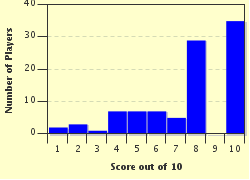Quiz Answer Key and Fun Facts
1. English landscape (and seascape) artist often known as the 'Painter of Light'.
2. Artist born in Constantinople who worked in Russia in the late 14th century.
3. Member of a famous family of artists who founded the Antwerp Royal Academy of Fine Arts.
4. Real name Tiziano Vecelli or Vecellio; this artist produced many of his works for King Philip II of Spain.
5. Aristocratic but alcoholic French artist; famous for his depictions of the nightlife of Paris.
6. American abstract artist of the 20th century who was awarded the Carnegie Prize in 1961.
7. French painter known for being a member of the 'Volcano School'.
8. This modern artist's work has been described as both "scribble-like" and "graffiti-like", but examples of it have sold for tens of millions of dollars.
9. 16th-century Venetian artist also called 'Il Furioso' due to the furious energy he is said to have devoted to his works.
10. American artist of the Art Nouveau period famous for producing lamps with stained glass shades.
Source: Author
Fifiona81
This quiz was reviewed by FunTrivia editor
bloomsby before going online.
Any errors found in FunTrivia content are routinely corrected through our feedback system.

